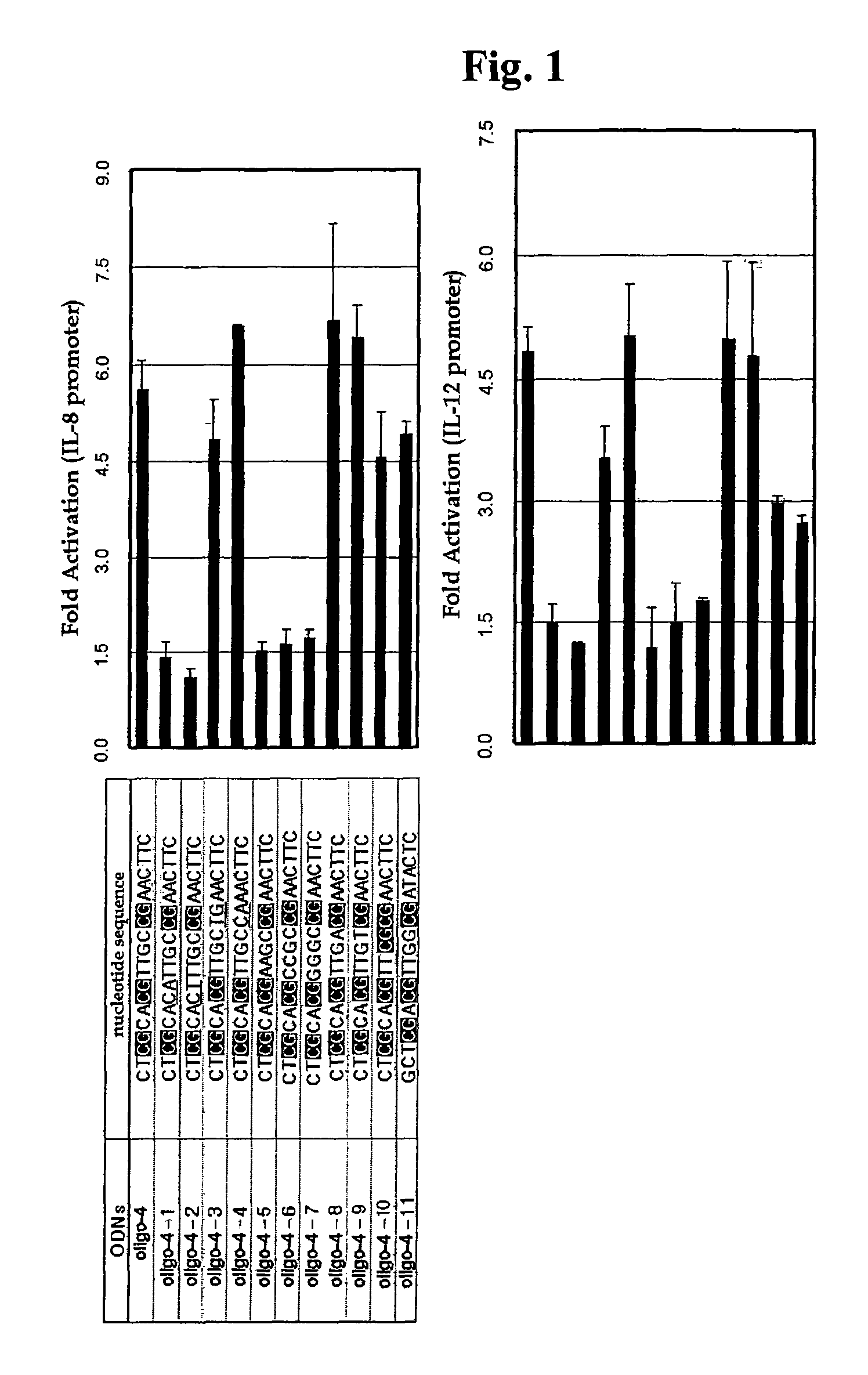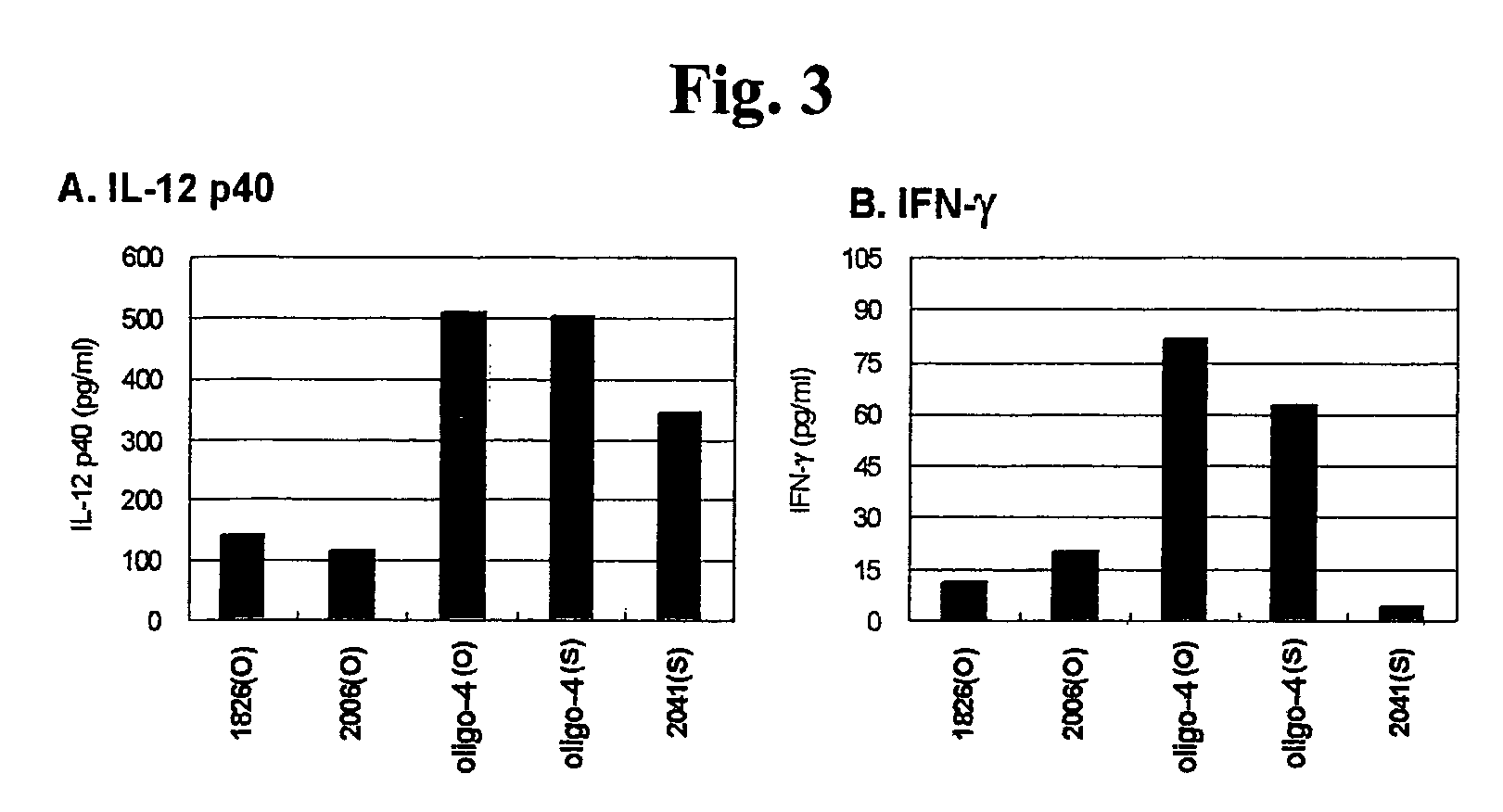Therapeutic use of CPG oligodeoxynucleotide for skin disease
a technology of oligodeoxynucleotide and skin disease, which is applied in the direction of immunological disorders, drug compositions, genetic material ingredients, etc., can solve the problems that the use of cpg odns with a phosphodiester backbone for the prevention and treatment of skin diseases has never been studied, and achieves excellent immunoactivity, enhanced activity and/or stability of cpg odn, and easy degradation
- Summary
- Abstract
- Description
- Claims
- Application Information
AI Technical Summary
Benefits of technology
Problems solved by technology
Method used
Image
Examples
example 1
Effect of Base Modification of Oligo-4 CpG ODN Upon Immune Responses
[0065] Isolation of Oligo-4 CpG ODN and Base Modification Thereof
[0066]A CpG ODN (referred to as “oligo-4 CpG ODN” hereinafter) having the nucleotide sequence represented by SEQ ID NO. 2, which induces immune responses to a high level, was isolated from an E. coli chromosomal DNA fragment partially cleaved by DNase I. Next, various mutants were prepared by modifying the nucleotide sequence of the oligo-4 CpG ODN, and tested to determine immune responses thereof. Base modification of the oligo-4 CpG ODN was performed as follows: The second CpG motif from the 5′-end in the nucleotide sequence of the oligo-4 CpG ODN (SEQ ID NO. 2) was substituted with CA and CT dinucleotides, and the resultant ODNs were designated as “oligo-4-1” and “oligo-4-2”, respectively. Also, the third CpG motif from the 5′-end in the nucleotide sequence of the oligo-4 CpG ODN (SEQ ID NO. 2) was substituted with TG and CA dinucleotides, and the r...
example 2
Effect of Backbone Modification of Oligo-4 CpG ODN Upon Immune Responses
[0080] Assay for Activation of IL-8 Promoter
[0081]Raw 264.7 Cells were Co-Transfected with Both the IL-8 Promoter-Luc promoter reporter vector, constructed as described in the above part b) of Example 1-2, and pRL-null plasmid (Promega). The transfected cells were treated with O-type (phosphodiester backbone) and S-type (phosphorothioate backbone) oligo-4 CpG ODN (0 or 10 μg / ml), respectively, and then cultured for 8 hours. Additionally, O-type 1826 ODN (SEQ ID NO. 18) and O-type 2006 ODN (SEQ. ID NO. 19) were used as control CpG ODNs in order to compare their activities with the activity of the oligo-4 CpG ODN of the present invention. Also, as a non-CpG ODN, S-type 2041 ODN (SEQ ID NO. 20) was used. Next, activity of the IL-8 promoter was measured in the same manner as described in Example .
[0082]As a result of the experiment, as shown in FIG. 2, activation patterns of the IL-8 promoter were different dependin...
example 3
In Vitro Assay for Immune Responses Related with Atopic Dermatitis
[0093] Assay for Activation of Dendritic Cells
[0094]The CpG ODN of the present invention was examined to determine whether it activates the dendritic cells isolated from an atopic dermatitis model animal.
[0095]a) Isolation of Dendritic Cells and CpG ODN Treatment
[0096]Progenitor cells were isolated from the bone marrow of the femoral region of the NC / Nga mouse (SLC, Hamatsu, Japan), which is an atopic dermatitis model animal. To the isolated progenitor cells, RBC lysis buffer (150 mM NH4Cl, 10 mM potassium carbonate, 0.1 mM EDTA pH 7.4) was added, and the reaction mixture was allowed to react at room temperature for 5 minutes. Next, the cells were collected by centrifugation, and were washed with serum-free RPMI medium three times. The cells were stained with trypan blue and the number of the cells was counted with a hematocytometer. The cells were applied to a 6-well plate (Nunc) at a concentration of 2×106 cells / wel...
PUM
| Property | Measurement | Unit |
|---|---|---|
| concentration | aaaaa | aaaaa |
| concentrations | aaaaa | aaaaa |
| concentration | aaaaa | aaaaa |
Abstract
Description
Claims
Application Information
 Login to View More
Login to View More - R&D
- Intellectual Property
- Life Sciences
- Materials
- Tech Scout
- Unparalleled Data Quality
- Higher Quality Content
- 60% Fewer Hallucinations
Browse by: Latest US Patents, China's latest patents, Technical Efficacy Thesaurus, Application Domain, Technology Topic, Popular Technical Reports.
© 2025 PatSnap. All rights reserved.Legal|Privacy policy|Modern Slavery Act Transparency Statement|Sitemap|About US| Contact US: help@patsnap.com



